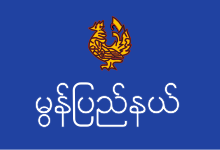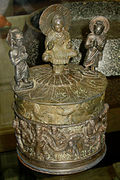Hamsa (bird)
The Hamsa (from Sanskrit हंस haṃsa) is an aquatic bird, often considered to be a goose or sometimes a swan. It is used in Indian and Southeast Asian culture as a symbol and a decorative element.
Identification
The word is cognate with Latin "(h)anser", Greek "χήν", German "Gans", English "goose", Spanish "ganso" and Russian "гусь" (all meaning a goose). Standard translations of the term from Sanskrit are as a goose first, and swans, other aquatic birds, or mythical birds as an alternative.[2] It is normally considered by ornithologists to be most likely to be the bar-headed goose (Anser indicus), a migratory bird that is commonly found in winter in the north of the subcontinent.
While the term has traditionally been translated into English as swan, it is considered unlikely to be the original meaning. In India swans are never found in feral populations and hardly ever in zoos, though they occur occasionally as vagrants.[3]
Identification with Brahman
The Hamsa represents perfect union, balance and life. A constant repetition of the word "hamso" changes it to "Soaham", which means "That I am". Hence the hamsa is often identified with the Supreme Spirit or Brahman. The flight of the Hamsa also symbolizes the escape from the cycle of samsara. The bird also has special connotations in the monistic philosophy of Advaita Vedanta - just as the swan lives on water but its feathers are not wetted by water, similarly an Advaitin tries to live in this material world full of Maya, but is unsoiled by its illusionary nature.
Mythology
A large volume of corpus of folklore and literature has grown around it, and a distinct mythology has evolved around the Hamsa. During Vedic times it was considered to relationship with Surya. Then, it signified strength and virility. With the emergence and consolidation of the Hindu scriptures of Upanishads, hamsa acquired more attributes, including being treated as a symbol of purity, detachment, divine knowledge, cosmic breath (prana) and highest spiritual accomplishment. Such a high level of symbolism was attached to hamsh as it transcends the limitations of the creation around it: it can walk on the earth (prithvi), fly in the sky, and swim in the water. The Hamsa was also used extensively in the art of Gandhara, in conjunction with images of the Shakyamuni Buddha. It is also deemed sacred in the Buddhadharma.
Lake Manasarovar in Hindu mythology, is seen as the summer abode of the Hamsa. Poetical images are derived from the flight of the swans to that lake in the Himalayas.[4]
It is said to eat pearls and separate milk from water from a mixture of both. In many texts it is extolled as the king of birds. In one of the Upanishads, a hamsa is also said to possess the sacred knowledge of the Brahman. The hamsa is also the vahana of the goddess Saraswati.
Philosophy
A school of philosophy has endeavored to penetrate its name. Ham-sa when inverted reads as sa-ham, which in Sanskrit means the oneness of human and the divine. During pranayama, which is a yogic exercise of breath control, the inhalation is believed sound like ham, while the exhalation is believed to sound like sa. Thus, a hamsa came to epitomize the prana, the breath of life.
Paramhamsa
In view of the association of a hamsa with several attributes as indicated above, saints and other holy persons are given the title of paramhamsa, that is, the supreme hamsa. This title is affixed before the name and symbolizes that the particular person has reached a high level of spirituality and grace, though it may also be affixed as a postposition, for example, Sri Ramakrishna Paramahamsa.
.jpg)
Contemporary usage
The name in other languages in which it is culturally important are Hindi: hans, Burmese: ဟင်္သာ, IPA: [hɪ́ɴθà], and commonly spelt hintha or hinthar; Mon: ဟံသာ, [hɔŋsa] or hongsa; Shan: ႁင်းသႃႇ, [haŋ˦ sʰaː˨] or hong; Thai: หงส์, [hǒŋ]. The hintha (hamsa) is widely depicted in Burmese art, and has been adopted as the symbol of the Mon people. It is also depicted on the subdivision flags of Bago Division and Mon State, both of which have been historic Mon strongholds.
-
Hamsa border on the Kanishka casket, 2nd century CE
-
Hamsa birds between the architectural spires on the Bimaran casket, 1st century CE
-

Flag of Bago Division, Myanmar, which depicts the hamsa
-

Flag of Mon State, Myanmar, which depicts the hamsa
See also
Further reading
- The Goose in Indian Literature and Art (Leiden, 1962) by J. Ph. Vogel
References
| Wikimedia Commons has media related to Hamsa. |
- ↑ British Museum Collection
- ↑ "Sanskrit, Tamil and Pahlavi Dictionaries" (in German). Webapps.uni-koeln.de. Retrieved 2013-10-19.
- ↑ "ANSERIFORMES - Birds of India - Ducks, Geese, Swans". Birding.in. Retrieved 2013-10-19.
- ↑ Kalidasa's maha-kavya Raghuvaṃśa
- Dictionary of Hindu Lore and Legend (ISBN 0-500-51088-1) by Anna Dallapiccola
| ||||||||||

